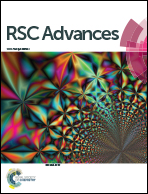Strange critical behaviors of ferromagnetic to paramagnetic transition in La0.5Ca0.5MnO3 nanowires bundles
Abstract
Highly ordered La0.5Ca0.5MnO3 nanowires bundles are synthesized using mesoporous SBA-15 silica as the hard template. The magnetic properties and critical behaviors of the ferromagnetic–paramagnetic (FM–PM) phase transition of the La0.5Ca0.5MnO3 nanowires bundles are investigated through isothermal magnetization methods. The calculated results show that the FM–PM transition is second order and the magnetic interaction has some deviations from the mean-field model. Though the obtained critical parameters of β = 0.596 ± 0.009, γ = 1.131 ± 0.008 and δ = 2.99 ± 0.05 follow the Widom scaling relation δ = 1 + γ/β and the single scaling equation M(H,|ε|) = εβf±(H/|ε|β+γ), the critical exponents do not obey the magnetization entropy scaling theory, indicating that the nanometer-size effect play a significant role on the magnetic phase transition and magnetic entropy for La0.5Ca0.5MnO3 nanowires bundles.


 Please wait while we load your content...
Please wait while we load your content...